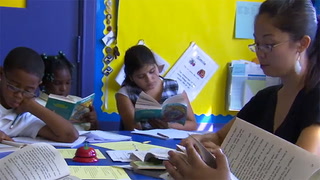Series Guided Reading with Jenna: Guided Reading with Jenna: Small Group Guided Reading
ELA.RL.5.10
| Common core State Standards
- ELA: English Language Arts
- RL: Reading Standards for Literature K-5
- 5: 5th Grade
-
10: By the end of the year, read and comprehend
literature, including stories, dramas, and poetry,
at the high end of the grades 4-5 text complexity
band independently and proficiently.
ELA.RF.5.4a
| Common core State Standards
- ELA: English Language Arts
- RF: Reading Standards: Foundational Skills (K-5)
- 5: 5th Grade
-
4a: Read with sufficient accuracy and fluency to
support comprehension.
a. Read on-level text with purpose and
understanding.
b. Read on-level prose and poetry orally with
accuracy, appropriate rate, and expression on
successive readings.
c. Use context to confirm or self-correct word
recognition and understanding, rereading as
necessary.
ELA.SL.5.1
Common core State Standards
- ELA: English Language Arts
- SL: Speaking and Listening
- 5: 5th Grade
-
1: Engage effectively in a range of collaborative
discussions (one-on-one, in groups, and teacherled)
with diverse partners on grade 5 topics and
texts, building on others'\x80\x99 ideas and expressing
their own clearly.
a. Come to discussions prepared, having read
or studied required material; explicitly draw
on that preparation and other information
known about the topic to explore ideas under
discussion.
b. Follow agreed-upon rules for discussions and
carry out assigned roles.
c. Pose and respond to specific questions by
making comments that contribute to the
discussion and elaborate on the remarks of
others.
d. Review the key ideas expressed and draw
conclusions in light of information and
knowledge gained from the discussions.
Save to My Resources
PLEASE CREATE A NEW ACCOUNT OR LOG IN TO ACCESS THIS CONTENT
Enjoy your first video for free. Subscribe for unlimited access.
Have questions about subscribing?
Click Here to learn more about individual subscriptions.
Click Here to learn more about School and Institution access.
Discussion and Supporting Materials
Thought starters
- What are the advantages of meeting with students in small groups?
- Notice how Ms. Ogier asks students to back up their opinions with text evidence How does Ms. Ogier differentiate for the second group?
School Details
Aspire Berkley Maynard Academy6200 San Pablo Avenue
Oakland CA 94608
Population: 587
Data Provided By:

Teachers
Jenna Ogier
English Language Arts Math Science Social Studies / 4 5 / Teacher
Newest
|
4 MIN
|
5 MIN
|
5 MIN
UNCUT CLASSROOMS
| TCHERS' VOICE
English Language Arts













23 Comments
John Ford Jun 14, 2022 12:19am
Clear expectations the teacher explains what is to be done first
John Ford Jun 14, 2022 12:16am
The teacher has read and prepared for small group and leads with questions about the text...
Anina Byerly May 27, 2022 10:31pm
Small group reading is so beneficial. The teacher gives more eye contact which can the grow the student- teacher connection. It can also make the student more comfortable to ask questions when confused. With the reading session, the teacher lead the conversation and asked questions to keep student engagement high. She praised students who were ready to start the session as well.
Jeremy Dixon Apr 20, 2022 11:04am
The advantage of small group reading is so that every level of reader is engauged in the assigned reading. The reading assignment will have the same questions or work to be done just at the reading level of each small group. For the non strong readers, the teacher ensured that they did the reading by asking questions. The second group of the guided reading was at a different level of reading but asked higher level questions with finding more support for the answers being given.
Jiala Wilson Oct 19, 2017 2:13am